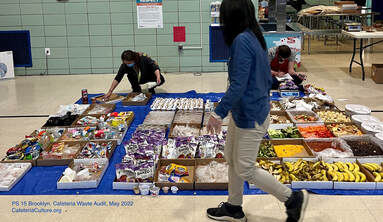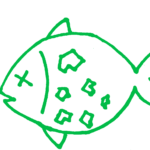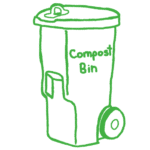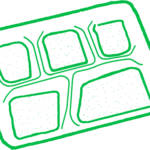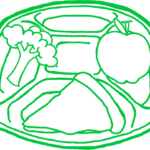


Next Plastic Free Lunch Day – November 17th – 21st, 2025!
Please join Cafeteria Culture for the sixth biannual Plastic Free Lunch Day (PFLD)! Over 3,000 schools across the country participated in November 2024.


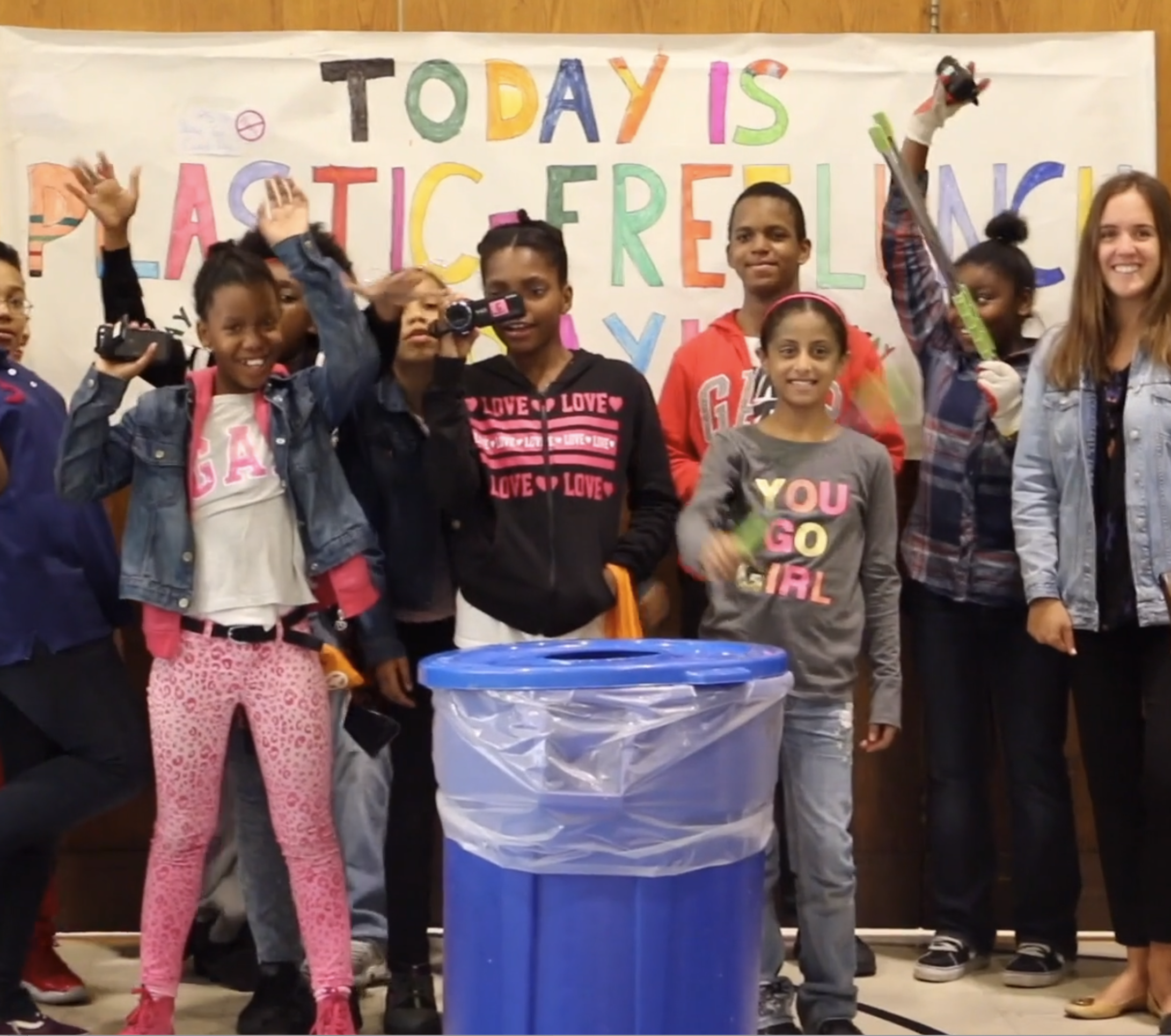
The first Plastic Free Lunch Day (PFLD) was spearheaded by fifty-six PS 15 fifth-graders in Red Hook Brooklyn, as portrayed in Cafeteria Culture’s award-winning movie, Microplastic Madness. On PFLD. Students conducted a before and after waste audit and on PFLD counted 558 fewer lunchtime single-use plastic items! On May 16, 2022, Cafeteria Culture in partnership with NYC Department of Education, and students led the first New York City-wide Plastic Free Lunch Day.
Plastic Free Lunch Day (PFLD) is now an official initiative in NYC Public Schools, taking place every three weeks in over 750 elementary schools. Together, these efforts have already eliminated more than 22 million single-use plastic items—proving that plastic-free school lunches are possible at scale.
PFLD has also grown into a biannual national movement, with over 3,000 schools across the country participating and inspiring students to take action for a more sustainable future.

PFLD isn’t just good for the environment—it’s cost-effective. By serving finger foods, offering utensils only by request, and using bulk condiment dispensers and unwrapped sandwiches, NYC Public Schools saved an estimated $8,000 in materials for every 100,000 student lunches served. That adds up to hundreds of thousands in potential annual savings—all while reducing millions of pieces of single-use plastic.

Schools across the U.S.—and around the world—are taking action! Explore our interactive map to see over 3,000 schools and organizations that have participated in Plastic Free Lunch Day, from New York City to California, and even beyond. Together, we’re building a global movement for plastic-free school meals.
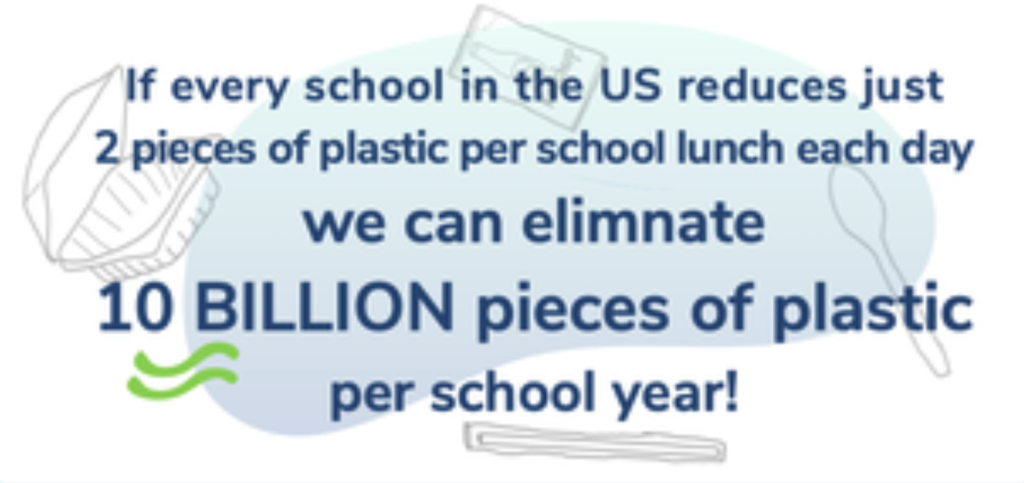
A: Show the “Get Ready” video and use our “Why Plastic Free Lunch Day? The Problem with Plastic” overview slides with discussion prompts. Get your students excited to be a part of a plastic free action day!
B: Show our award winning movie,
Microplastic Madness
Free for all K-12 schools Oct-Nov 2023 ->
You will receive the link automatically after completing this short form.
Spanish-Subtitled Version available
Always free for Title 1 or under-resourced schools

Plastic threatens health & environment. And many plastics are unnecessary. That means we don’t have to use them! Screen our award-winning student-led movie Microplastic Madness in your school or classroom.
Watch the movie trailer here ->
Use our free Movie Companion Guide & Discussion Questions.
Screen the movie (76 minutes) with your class, Green Team, club or entire school to educate and inspire action!Choose to watch in 2, 3, or 5 parts, or show the entire movie at once.
Meet with your principal and school food manager to find out if your school is participating on Plastic Free Lunch Day. If not, request a Plastic Free Lunch Day or a plastic free action day at your school.
Here are some ideas: (scroll down to “Easy Plastic Free Actions” a complete list)
– Hand out “Utensils by request only” every day
– Provide dressings & condiments in bulk (such as refillable pump jars) rather that in individual packages
– Wrap sandwiches in bulk rather that individually every day
– Make all pizza menus days plastic-free
– Make all “hand-held” menu days (i.e. burger, taco, burrito, egg roll) plastic free days too!
– Offer more menu items that do not require utensils (burrito, burger, tacos, oranges, bananas)
Create signs (or print out the signs in Resources” below) and post them around the school and in the cafeteria.
Ask for a slot during Morning Announcements to explain the idea & plan.
Arrange for students to visit all classrooms to explain the idea & plan to other students.
Present at a PTA meeting. Ask parents to support school (not home) lunches on the action day.
Request that Plastic Free Lunch Day be added to the school calendar.
Set up an info-table in the cafeteria.
Set up a sorting station (or improve the ones that already exist) and monitor the stations to increase awareness (use our SORT2save/Cafeteria Ranger resources for setting up sorting stations with student monitors).
Take Photos (this is easy!)
**PHOTO HOW-TO: Take the photos at the end of a lunch period or all lunch periods. Position the camera above each cafeteria trash, recycling, and compost bin so all items can be clearly seen. (If your school does not have Organics Collection, we still want to see the contents of all the other bins).
(“After” means the day-of PLASTIC FREE LUNCH or another plastic reduction day, at the end of the lunch period)
Publicize your success with your before and after data & photos.
Or
Conduct a CAFETERIA PLASTIC SURVEY
Students collect & count single-use plastic in their cafeteria
Instructions for Lunch or Breakfast Survey

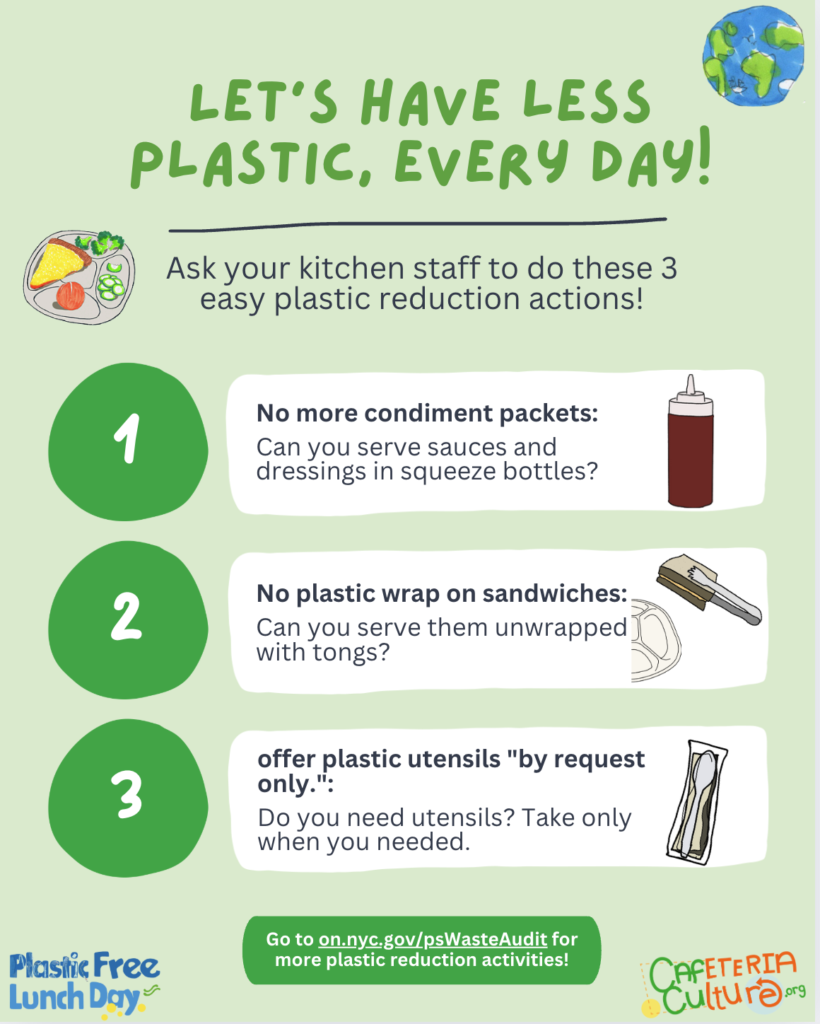
The world is awash in toxic and polluting single-use plastics made from hazardous chemicals that are contaminating our ecosystems, our communities and our bodies. The US creates more plastic waste than any other nation and it never goes away. It degrades into tiny microplastics and then nanoplastics. Scientists have found microplastics in the deepest parts of the ocean, and in our soil, food, water and air, and in our bodies.
380 million metric tons of plastic are produced each year.
The US plastic recycling rate has dropped below 6%!
US Schools serve 7.35 billion meals annually. Those meals are packed with non-biodegradable Single-use plastics (SUPs) that make a significant contribution to the US plastic waste stream and the staggering global plastic pollution problem. Most of those SUPs end up in a landfill or environment.
Plastic Free Lunch Day provides students an opportunity to learn about plastic pollution and take meaningful plastic-reduction action. One plastic free day leads to another and creates a vision and actionable ideas to move forward equitably and sustainably.
Each year, we produce over 350 million metric tons of plastic; more than 40% of this is single-use plastic–plastic packaging and foodware that is used for less than 20 minutes. Because plastic is not recyclable, most discarded plastic is sent to landfills or “leaks” into the natural environment.
Plastic does not biodegrade. Instead it breaks or fragments into small particles called microplastics and then into smaller particles called nanoplastics. Because plastic is made from fossil fuels and thousands of persistent toxic chemicals, they transfer thousands of migrating chemicals into our food during use. After disposal and fragmentation, plastic particles carry and distribute these toxic chemicals to every inch of the globe.
Scientists have found micro and nanoplastics in our digestive tract, deep in our lung tissue, in the placenta, and circulating in our blood. Nanoplastics deliver thousands of toxic chemicals directly to the organs, tissues, and cells in our bodies. We now face the public health crisis of our time.
School cafeterias serve over 40 million meals a day and make a large contribution to the plastic waste stream. School cafeterias are a great place to begin reducing single-use plastics, while also protecting the health of our students–society’s most vulnerable members. Plastic Free Lunch Day is a first step that results in useful photos and data but, most importantly, it shows everyone that food-dispensing and eating does not require plastic!
Simplify the day with a focus on reducing just one kind of single-use plastic packaging, such as a:
We suggest always starting with a before survey (or audit).
Example: the steps for a “NO PLASTIC STRAW DAY”:

– BRING YOUR OWN FORK (and napkin) DAY
– BRING YOUR CUP or REUSABLE BOTTLE DAY
From the movie, “Microplastic Madness”
Ask your food service manager to:
Thank your kitchen and custodial staff and school cafeteria aides!
Showing gratitude supports positive change-making and builds community!
For inspiration, show our video, “School Lunch in Japan- it’s not just about eating” (34 million views on YouTube!)



Latest article about NYC PFLD, November 22nd, 2024
NEW YORK CITY – New York City schools participated in the fifth biannual Plastic Free Lunch Day earlier this week, as part of a growing national effort to eliminate single-use plastics in school cafeterias across the country. READ MORE







